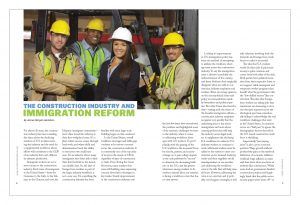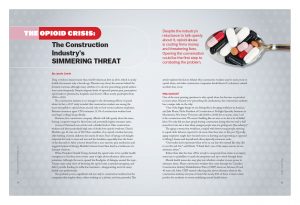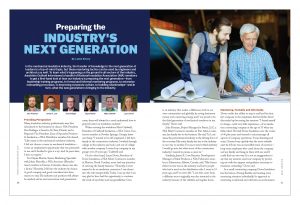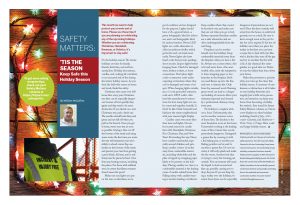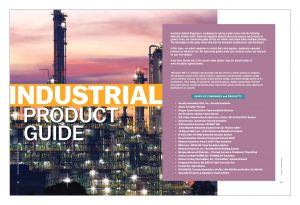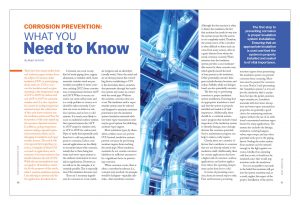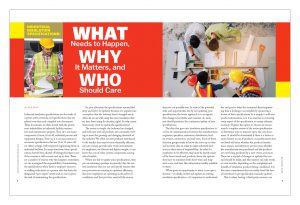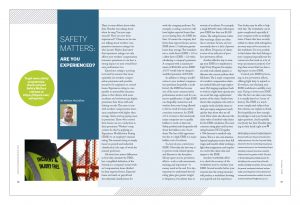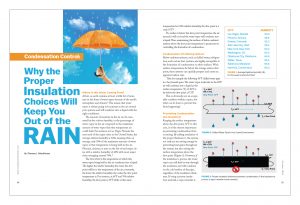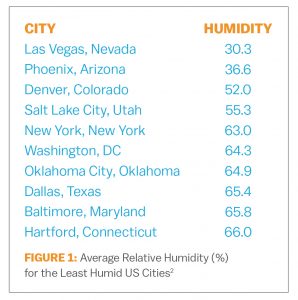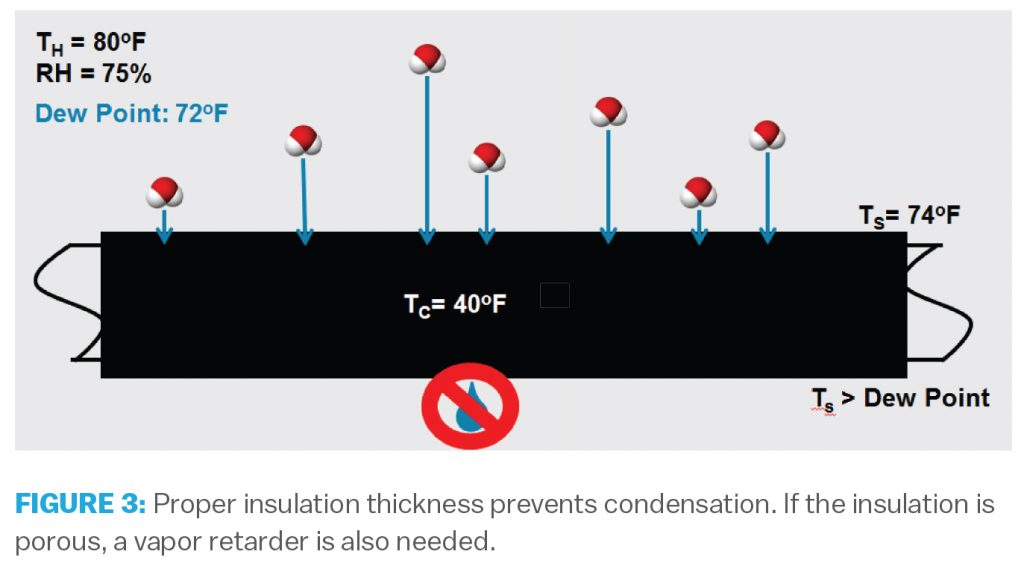For almost 20 years, the construction industry has been sounding the alarm about the declining numbers of U.S. workers entering the industry and the need for a supplemental workforce whose efforts will contribute to the GDP of an industry that can’t offshore its ultimate production.
Immigrant workers are not a new concept to the construction industry. Each wave of immigrants to the United States—from the Germans, to the Irish, to the Italians, to the Chinese, and now, the Hispanic immigrant community— have often found the industry as their first workplace home. It’s a place where success comes through hard work, and where skills and determination breed the ability to start your own small business. It’s an industry where many immigrants have been able to find their first foothold in the American middle class. So, the idea of foreign-born workers as part of the larger industry workforce is not a new one. It’s something the construction industry has been familiar with since large-scale building began on this continent.
In the United States, overall workforce shortages and skills gaps continue to be serious concerns across the construction industry. It is consistently one of the top areas of worry in the minds of CEOs, regardless of type of construction or trade. Even during the Great Recession, many markets that were still building were expressing concern about labor shortages in key trades. Steady improvements in the construction industry over the last few years have exacerbated the problem and highlighted some of the systemic challenges we have in the industry when it comes to addressing workforce shortages with U.S. workers. To put it plainly, with the graying of the U.S. workforce; the increased focus by schools, parents, and society-at-large on 4-year college degrees as the only pathway for “success” in America; the decreasing birth rate in the U.S.; and the greater reluctance among workers to do outdoor manual labor, our industry is facing a workforce crisis that has no easy answer.
Looking to improvements in U.S. immigration policy has been one method of attempting to address the workforce shortage issue across the construction industry. To say the immigration issue is divisive is probably the understatement of the century, and those divisions don’t magically disappear when you talk to construction industry employers and workers. There are strong opinions on the macropolitical issues and policy recommendations made by lawmakers and political parties. But what I have also found is that—setting aside the chaos of the broader immigration debate—construction industry employers recognize very quickly that the underlying issue is less about immigration and more about creating policies that will help the industry access legal workers to supplement the declining U.S. workforce. In order for U.S. industry workers to continue to work, additional workers must be added to the system to meet construction sector demand.
Industry trades and their suppliers are all interdependent on one another and addressing the workforce crisis is the tide that will help raise all boats. However, addressing the crisis is no easy feat, and it probably can’t happen overnight; it will take solutions involving both the domestic and foreign-born workforces to make it successful.
The idea that U.S. workers would do these jobs if paid more money is quite common and comes from both sides of the aisle. Both parties have political incentives from their respective bases to not support viable immigrant and temporary worker programs that benefit what the government calls the “low-skilled sectors” like construction. This idea that foreign-born workers are taking jobs that Americans are clamoring to do is one that gets repeated across the ideological spectrum, intentionally failing to acknowledge the real workforce challenges that exist in the United States. It somehow serves as a “hall pass” to ignore the demographics factors that tell us the U.S.-based construction workforce is shrinking.
Importantly, “just paying more” is also a poor economic position. Wage growth without productivity gains is the textbook definition of economic inflation. Artificial wage inflation is easier said than done when you have an industry like construction. While some look at government-funded construction projects and laughingly think that the public sector money spigot never shuts off—so it doesn’t matter how far over budget you run—most projects happen in the private sector where market impacts that drive projects over-budget can quickly impact whether a project happens at all. In the case of residential construction, the negative ripple effect is easy to see, as any significant increase in labor costs or materials directly impacts the selling price of a home and thus the ability for potential buyers in the marketplace to qualify for the mortgage on that home. Artificial wage growth doesn’t fix the underlying problem of a shrinking workforce, but it can negatively impact the overall health of the sector—thus potentially harming the very U.S. workers it attempts to aid.
What Comes Next?
Currently, the industry is facing real and significant workforce shortages and skills gaps; a decreasing pool of U.S. workers willing and able to take on these jobs; a highly politicized immigration policy debate; and a foreign-born workforce outside of our nation
that potentially represents a good and an efficient method for securing a legal, supplemental workforce to assist the industry. Unfortunately, not enough progress is being made on utilizing this potential workforce.
First, it’s important to remember that Congress and the federal government at large are typically reactive bodies. The system isn’t designed for policymakers and lawmakers to see an issue coming down the pike and step in to address it before it happens. Rather, the system is designed and operates as a response system. Only after the crisis hits does the system start coming up with a response. The private sector is seeing and feeling the workforce crisis, and it’s a problem that will persist. For policymakers however, it is seen as less of a crisis because the economy is still functioning. It is up to industry participants to draw attention to the seriousness of the issue.
When it comes to the domestic U.S. workforce, one key objective must be to come up with training programs and education incentives that will encourage U.S. workers—including those non-traditional industry participants such as women—to look into jobs in the industry. Industry groups need to work on the ground with community colleges, high schools, and guidance counselors to help them understand that there are many great, lifelong careers to be had in the construction industry—and help them to develop the syllabus, classes, and training programs that teach skills that fit what employers actually need in the real world. The fact that the industry has traditionally been characterized by
de-centralized relationships can be a problem—while many groups have efforts toward training, there is little coordination between different groups. Collaborating on training efforts will be vital to success—as well as making the worker shortage and skills gap crisis a collective top priority.
Lawmakers need a better understanding of the private sector construction marketplace as it relates to a foreign-born workforce. The stark reality is that in order for the industry to continue to meet demand, and in order for the industry to thrive and continue to contribute to the GDP of the United States, the industry needs access to a legal, viable, supplemental workforce that fills our labor shortages and skills gaps. It’s important that Congress and the administration begin to take these concerns seriously and start
working with the industry to identify fair, efficient, and workable programs that allow industry employers to hire supplemental workers when the economy needs them. The construction industry cannot build bridges, road, buildings, or homes in another country and then ship them to the United States; it needs a domestic workforce to continue
to complete projects of this nature.
For almost 20 years, the construction industry has been at the forefront of pushing lawmakers and administrations on both sides of the aisle to create a year-round work visa program for workers to enter the United States to work in the industry when the economy and the sector need their supplemental assistance. Under my organization’s industry proposal, workers could enter on a 3-year visa and would be restricted to working with only those employers who have demonstrated that U.S. workers are not ready, willing, and available to do those jobs. The creation of this type of visa program is a complicated matter, but it is one that the government cannot continue to ignore. Today, the federal government provides a legal work visa program for the agriculture sector (H-2A); a legal work visa program for the high-tech sector (H-1B); and a small seasonal visa program that is used most often by landscapers and resorts for seasonal work (H-2B). There is absolutely no program of legal work visas to cover the rest of the economy.
There are a few key objectives for my organization moving forward: (1) prioritize the workforce shortage as a top issue; (2) coordinate with one another on training programs and opportunities for U.S. workers, students, and non-traditional industry participants like women; and (3) coordinate messaging about the importance of the jobs available in the industry, as well as the potential for long, successful careers and small businesses throughout the trades. Construction must continue to push lawmakers to provide the construction industry with the same level playing field of access to foreign-born workers that the agriculture and high-tech sectors already receive. The challenges facing the industry are very real, and it will take effort, creativity, and common-sense policy changes to address both the domestic U.S. workforce, and our need for supplemental foreign-born workers.
Copyright Statement
This article was published in the December 2018 issue of Insulation Outlook magazine. Copyright © 2018 National Insulation Association. All rights reserved. The contents of this website and Insulation Outlook magazine may not be reproduced in any means, in whole or in part, without the prior written permission of the publisher and NIA. Any unauthorized duplication is strictly prohibited and would violate NIA’s copyright and may violate other copyright agreements that NIA has with authors and partners. Contact publisher@insulation.org to reprint or reproduce this content.

